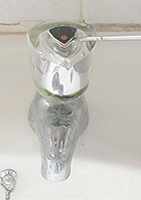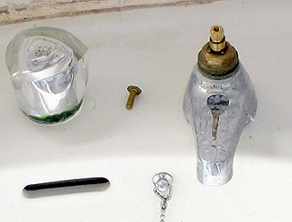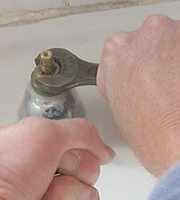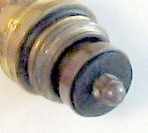Replacing a tap washer
One of the most common plumbing jobs around the home is replacing a worn tap washer to stop a dripping tap, here we show you how to make this a simple job.
 Pillar tap diagram
Pillar tap diagram
- First turn off the water supply to the dripping tap, and turn on the tap to release any water in the system feeding it.
- Before you start to dismantle the tap, place the plug in the outlet of the basin or sink - this will prevent any small items you drop from going down the waste.
-


remove insert exposed screw Remove the top of the tap.
Most modern taps have 'shroud' knobs with a red or blue marking to indicate if the tap is hot or cold water. These markings are often on a small insert in the centre of the top of the knob, these inserts usually hide the screw which holds the knob on the spindle.
Use a small screwdriver to lever off the insert to expose the screw holding the knob. -
 Remove the screw and the handle should lift off.
Remove the screw and the handle should lift off. -
 The next step is to release the tap valve, use a correct sized spanner above the joint and firmly hold the tap spout to prevent the body of the tap turning on the basin or sink - if the tap does move, the connection under the basin/sink may be loosened causing a leak.
The next step is to release the tap valve, use a correct sized spanner above the joint and firmly hold the tap spout to prevent the body of the tap turning on the basin or sink - if the tap does move, the connection under the basin/sink may be loosened causing a leak. -
 Undo the valve completely and remove. Not all taps have detachable valve jumpers.
Undo the valve completely and remove. Not all taps have detachable valve jumpers. -
Some valves have a small retaining nut for the washer, as right. Others have the washer simply pushed onto a central lug. Either undo the nut to release the old washer or prise the old washer over the lug. Each uses the same style of replacement washer.
 nut retained washer
nut retained washer central lug
central lug
- Replace the washer and, if appropriate, replace the nut.
 Before replacing the tap valve check to make sure that the tap seat is not undamaged, if it is damaged, repair it before replacing the valve. A new washer will not cure a dripping tap if the seat is damaged. The seat shown right has a sign of damage as indicated and needs regrinding. See this page for details.
Before replacing the tap valve check to make sure that the tap seat is not undamaged, if it is damaged, repair it before replacing the valve. A new washer will not cure a dripping tap if the seat is damaged. The seat shown right has a sign of damage as indicated and needs regrinding. See this page for details.
- Assembly of the repaired tap valve and knob is the reverse of dismantling.
